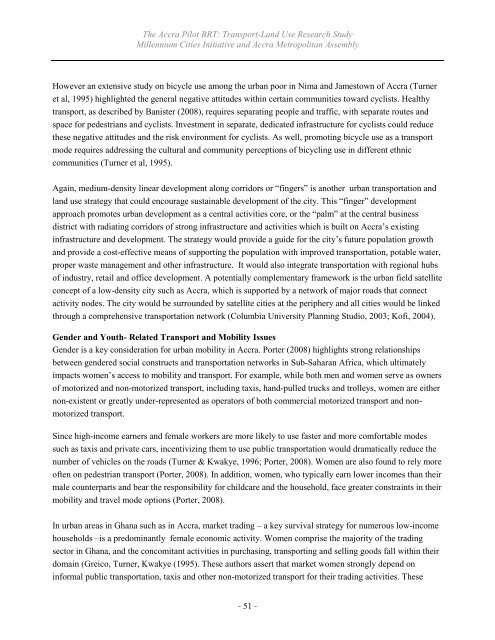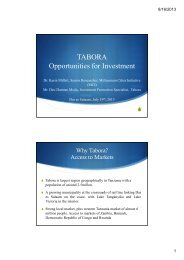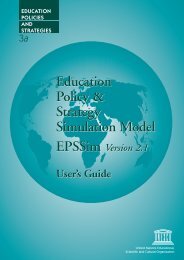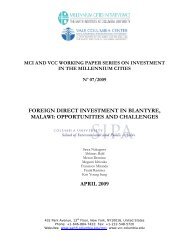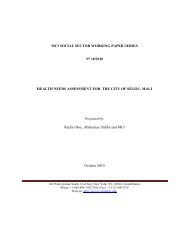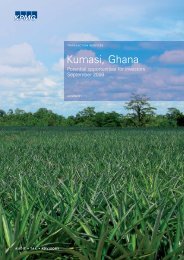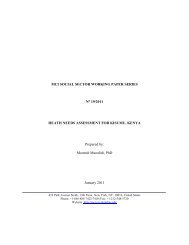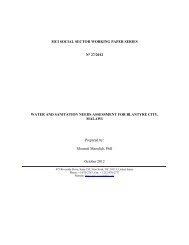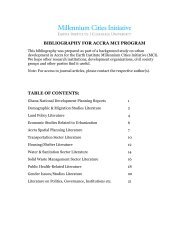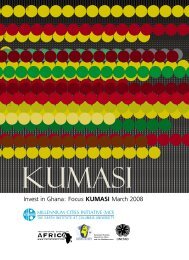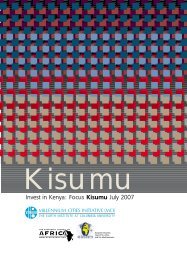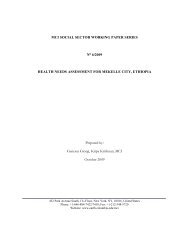Transport-Land Use Research Study - Millennium Cities Initiative ...
Transport-Land Use Research Study - Millennium Cities Initiative ...
Transport-Land Use Research Study - Millennium Cities Initiative ...
You also want an ePaper? Increase the reach of your titles
YUMPU automatically turns print PDFs into web optimized ePapers that Google loves.
The Accra Pilot BRT: <strong>Transport</strong>-<strong>Land</strong> <strong>Use</strong> <strong>Research</strong> <strong>Study</strong><br />
<strong>Millennium</strong> <strong>Cities</strong> <strong>Initiative</strong> and Accra Metropolitan Assembly<br />
However an extensive study on bicycle use among the urban poor in Nima and Jamestown of Accra (Turner<br />
et al, 1995) highlighted the general negative attitudes within certain communities toward cyclists. Healthy<br />
transport, as described by Banister (2008), requires separating people and traffic, with separate routes and<br />
space for pedestrians and cyclists. Investment in separate, dedicated infrastructure for cyclists could reduce<br />
these negative attitudes and the risk environment for cyclists. As well, promoting bicycle use as a transport<br />
mode requires addressing the cultural and community perceptions of bicycling use in different ethnic<br />
communities (Turner et al, 1995).<br />
Again, medium-density linear development along corridors or “fingers” is another urban transportation and<br />
land use strategy that could encourage sustainable development of the city. This “finger” development<br />
approach promotes urban development as a central activities core, or the “palm” at the central business<br />
district with radiating corridors of strong infrastructure and activities which is built on Accra‟s existing<br />
infrastructure and development. The strategy would provide a guide for the city‟s future population growth<br />
and provide a cost-effective means of supporting the population with improved transportation, potable water,<br />
proper waste management and other infrastructure. It would also integrate transportation with regional hubs<br />
of industry, retail and office development. A potentially complementary framework is the urban field satellite<br />
concept of a low-density city such as Accra, which is supported by a network of major roads that connect<br />
activity nodes. The city would be surrounded by satellite cities at the periphery and all cities would be linked<br />
through a comprehensive transportation network (Columbia University Planning Studio, 2003; Kofi, 2004).<br />
Gender and Youth- Related <strong>Transport</strong> and Mobility Issues<br />
Gender is a key consideration for urban mobility in Accra. Porter (2008) highlights strong relationships<br />
between gendered social constructs and transportation networks in Sub-Saharan Africa, which ultimately<br />
impacts women‟s access to mobility and transport. For example, while both men and women serve as owners<br />
of motorized and non-motorized transport, including taxis, hand-pulled trucks and trolleys, women are either<br />
non-existent or greatly under-represented as operators of both commercial motorized transport and nonmotorized<br />
transport.<br />
Since high-income earners and female workers are more likely to use faster and more comfortable modes<br />
such as taxis and private cars, incentivizing them to use public transportation would dramatically reduce the<br />
number of vehicles on the roads (Turner & Kwakye, 1996; Porter, 2008). Women are also found to rely more<br />
often on pedestrian transport (Porter, 2008). In addition, women, who typically earn lower incomes than their<br />
male counterparts and bear the responsibility for childcare and the household, face greater constraints in their<br />
mobility and travel mode options (Porter, 2008).<br />
In urban areas in Ghana such as in Accra, market trading – a key survival strategy for numerous low-income<br />
households –is a predominantly female economic activity. Women comprise the majority of the trading<br />
sector in Ghana, and the concomitant activities in purchasing, transporting and selling goods fall within their<br />
domain (Greico, Turner, Kwakye (1995). These authors assert that market women strongly depend on<br />
informal public transportation, taxis and other non-motorized transport for their trading activities. These<br />
- 51 -


